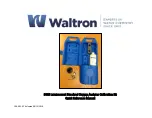
TD_GOLD_40-BA-e-1813
9
3-11 Coupling indicator
3-12 Base plate
3-13 Velocity key
3-14 RS-232C interface
12.4 Material selection
a) The instrument has to be switched on by the Power- key 3-4.
b) The code `cdxx` or `xxxx` will be shown on the display 3-2.
`cd` is the abbreviation for `code` and `xx` is a number among 0.1 and 11 which
stands for the material to be measured as shown in the scale below.
.`xxxx` is a 4-digit number describing the sound velocity of the material defined by the
user.
The `cdxx` material relationship is as follows:
Nr.
Code
Material
1
2
3
4
5
6
7
8
9
10
11
12
cd01
cd02
cd03
cd04
cd05
cd06
cd07
cd08
cd09
cd10
cd11
xxxx
Steel
Cast iron
Aluminium
Red copper
Brass
Zinc
Quartz glass
Polyethylene
PVC
Grey cast iron
Nodular cast iron
Sound velocity
c) The Plus key 3-6 or the Minus key 3-9 has to be pressed to select the material
code to measure. Then the material selection key 3-5 has to be pressed to confirm.
The instrument changes into the measuring mode and on the display occurs `0`.
If a material code is selected without confirming this selection, the instrument will
automatically change back into the measuring mode after a few seconds.
In this case the primary material code will still be stored before switching off.
d) A 4-digit number will be shown on the display by pressing the Plus key 3-6 when
displaying `cd11`or the Minus key 3-9 has to be pressed when displaying `cd01`.
The 4-digit number is the last sound velocity being defined by the user. By changing
velocity, varying qualities of materials can be compensated.
e) If the material code has once been selected and saved, it is stored in the memory
of the instrument. As long as no modification is done, the instrument will always raise
(use) this material code.





























